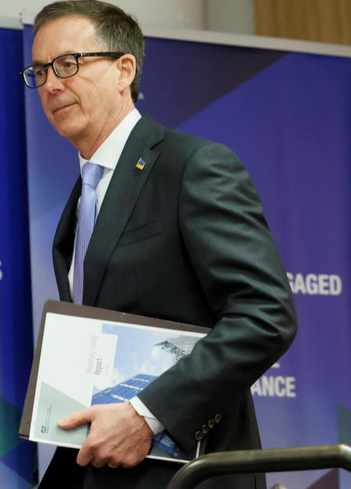 By Pepper Parr
By Pepper Parr
December 21st, 2023
BURLINGTON, ON
Different view on the housing issue.
Desperate situations for many people, not much in the way of hope for those who want to buy a home and intense pressure on those who rent.
A greater share of Canadians are barred from home ownership as affordability hits near-worst levels for most markets amid soaring prices and interest rates, according to a recent RBC report.

Robert Hogue, RBC economist: “The impact on affordability has been amplified by soaring interest rates and home prices, resulting in much larger mortgage payments,”
The significant loss of affordability during the pandemic has shrunk the pool of homebuyers in Canada, said Robert Hogue, RBC economist and report author. In 2019, close to 60 per cent of all households could afford to own at least a condo apartment based on their income. That share has plummeted to 45 per cent in 2023. And just 26 per cent can afford a single-family home.
“The impact on affordability has been amplified by soaring interest rates and home prices, resulting in much larger mortgage payments,” he said, “meaning a much higher household income is needed to carry those costs. These soaring costs have reduced the number of people who can afford a property.”
Ontario and B.C. had the highest incomes needed to afford a home, the report said. Using RBC’s housing affordability measures, which calculates how much of a household’s pre-tax income is needed to cover home ownership costs such as mortgage, utilities, and property tax, Toronto’s affordability measure rose to 84 per cent (meaning it takes 84 per cent of a Toronto median household income to cover housing costs) and Vancouver’s reached 102 per cent. Housing is considered affordable when 30 per cent or less of a household’s income is used to cover housing costs.
While home prices in Toronto have fallen by almost 20 per cent since the February 2022 peak, home prices remain elevated compared to pre-pandemic levels. The average price of a home in November was $1.08 million compared to $843,600 in the same month in 2019, according to the Toronto Regional Real Estate Board.
With fewer people able to buy condos, which are seen as starter homes for many as they’re cheaper than single-family homes, more pressure will be placed on the rental market, said David Macdonald, senior economist with the Canadian Centre for Policy Alternatives.
The affordability of home ownership affects the rental market for two reasons, he said. Renters won’t be financially able to move out of the market, increasing rental demand; and landlords facing costly mortgage increases will off-load the expenses to renters.
“Not only has housing affordability become worse for home ownership, but it’s also become worse for the renter,” he added.

The good news is that housing affordability’s recent rapid deterioration has likely run its course.
The good news is that housing affordability’s recent rapid deterioration has likely run its course, said Hogue, as home prices drift lower or stabilize in most markets, household income grows at a solid pace, and there’s clear indication from the Bank of Canada that rate cuts are coming in 2024.
“Nonetheless, there’s a very long way to go before affordability is meaningfully restored,” Hogue said in his report. “Buyers in many of Canada’s large markets will contend with extremely difficult conditions for some time. We expect home resale activity to stay especially quiet in Ontario and British Columbia until interest rates fall materially. And then, the recovery that will follow is likely to be gradual at first.”
In Toronto, it’s unlikely home ownership will be affordable, but there are ways to ensure the city can create more varied housing stock, Hogue said, especially for renters. Building more purpose-built rental and subsidized housing is necessary to boost affordable supply. Removing GST from new rental construction has also been seen as a positive step to incentivize more rental new-builds from developers, he added.
“There is a lot of potential to make things more affordable, especially on the rental side,” said Hogue. “But Toronto is not unique. Like most major global cities, it has affordability issues. While we have a long way to go in terms of supply, there is a lot that can be done to give people more affordable options.”
 Storey; an online source of news on the housing markets had this to say:
Storey; an online source of news on the housing markets had this to say:
This year, more than any other in recent history, saw real estate make its way into the every day conversations of Canadians, discussing mortgage rates around the dinner table and rapidly rising home prices with friends. And, for better or worse, 2023 had no shortage of important real estate stories to be told.
We began the year with yet another rate hike, setting the tone for the crushing rate pain and affordability struggles that were to follow throughout 2023. This year saw home sales drop off as buyers moved to the sidelines, rent prices skyrocket, sale prices start to slip (though not enough to be helpful), and developers hold off, sell off, or, in some cases, even go bankrupt, as they struggled with the uncertain market.
The issue that ties it all together is interest rates.
Interest rates on insured five-year fixed mortgages are dropping to levels not seen since May due to strong indication from central banks that monetary tightening is likely over as inflation falls closer to target.
Most fixed-rate mortgages are tied to the five-year bond yield, meaning when the bond yield goes up so does the interest on fixed-rate mortgages. Because the Bank of Canada and U.S. Federal Reserve are holding their respective rates and inflation has lowered, bond yields fell as markets began pricing in the possibility of rate cuts in the first half of 2024.
In the wake of this optimism, said Victor Tran, Ratesdotca mortgage and real estate expert, lenders have lowered their published five-year fixed rates below five per cent for the first time since May.
“We are seeing rates in the high fours, around 4.99 per cent, for five-year insured fixed rates, and roughly 5.59 per cent for uninsured,” he said. “We haven’t seen fixed rates this low since the spring. If bond yields continue to dip, we may see lenders lowering rates more in the coming weeks. These lower rates combined with falling home prices may help spur interest in the housing market ahead of the seasonal spring rush in 2024.”
An insured mortgage applies to buyers who put down less than 20 per cent for their down payment — the less money put down on the mortgage the higher the liability for the lender.

Royce Mendes, managing director and head of macro strategy at Desjardins.
Since the end of October, 10-year Canadian bond yields have fallen by 95 basis points, which is a “big fall,” said Royce Mendes, managing director and head of macro strategy at Desjardins. The fall can be attributed to the combined result of decelerating inflation and more “dovish” commentary from central bankers, meaning the bank is unlikely to make aggressive moves on interest rates in the future.
“Anyone with a mortgage up for renewal is no doubt pleased to see mortgage rates falling,” he said. “Assuming further progress on taming inflation in the new year, it’s likely that bond yields, and by extension mortgage rates, continue on this downward trajectory. That said, progress rarely occurs in a straight line and there are likely to be some temporary increases in yields along the way.”
 Tran evaluated published interest rates from TD, Scotiabank and HSBC but noted that not all the banks will publish their “absolute best” rates. Sometimes better deals can be won on a case-by-case basis.
Tran evaluated published interest rates from TD, Scotiabank and HSBC but noted that not all the banks will publish their “absolute best” rates. Sometimes better deals can be won on a case-by-case basis.
“The strength of the deal matters, such as the size of the mortgage, the down payment,” said Tran, “and from there banks can offer lower interest rates; they make you fight for the lowest rate.”
Currently, mortgage broker Ron Butler is offering interest of 4.89 per cent for five-year fixed mortgages at his practice.
“Five-year bonds come down first, which will be followed by four-year and three-year,” said Butler. “Fixed-rates went up before variable and now we’re seeing the reverse.”
And even though fixed-year mortgage rates are coming down first, variable-rate mortgages are gaining popularity, he said, as people don’t want to lock into a five-year fixed rate if the Bank of Canada drops rates in 2024.
“If the five-year fixed rate will be one per cent lower this time next year, people won’t want to lock into that mortgage product now,” Butler said. “They’d rather go for the variable based on the high chance the prime rate comes down.”
Recently, the majority of Tran’s clients have opted for a variable-rate mortgage because they don’t want to “lock in” too high. Even with current variable rates in the six to seven per cent range at the Big Five banks, buyers are willing to “ride it out” if the Bank of Canada cuts rates soon.
BoC Governor Tiff Macklem on getting to 2%:

Macklem: This strength in shelter price inflation appears to be related to the structural lack of supply of housing.
“This was our second year of monetary policy tightening, and that work is paying off”.
“The 2% inflation target is now in sight,” Bank of Canada (BoC) Governor Tiff Macklem said in his year-end remarks on Friday. “And while we’re not there yet, the conditions increasingly appear to be in place to get us there.”
Macklem delivered his remarks before the Canadian Club Toronto last week, where he spoke on the inflation outlook for 2024, as well as what Canadians can expect from the BoC in the year to come.
“We’ve come a long way toward restoring price stability. This was our second year of monetary policy tightening, and that work is paying off. The economy is no longer overheated, and that is relieving inflationary pressures. Inflation has come down from just over 8% in the middle of last year to 3.1% in October. That’s significant progress,” Macklem said.

Shelter price inflation will prove to be more stubborn in 2024, Macklem warned.
“Looking ahead, I expect 2024 to be a year of transition. The effects of past interest rate increases will continue to work through the economy, restraining spending, and limiting growth and employment. Unfortunately, this is what’s needed to take the remaining steam out of inflation. But this period of weakness will pave the way to a more balanced economy.”
We’re going into 2024 with relatively healthy inflation for durable and semi-durable goods (things like furniture and appliances, and clothing and footwear), Macklem also noted.
“Increases in the cost of services excluding shelter is just over 2%. That’s pretty normal. What’s not normal is inflation in the prices of food and non-durable goods and in shelter costs.”
While food price inflation (at about 5.5%), and non-durable goods inflation (at about 4.5%) are still swinging high, they “show some promise,” according to the BoC Governor. Food price inflation is expected to trend lower “as lower agriculture prices and transportation costs get passed through to the prices of groceries” and non-durable goods price inflation is anticipated to level off as consumer demand slows.
However, shelter price inflation will prove to be more stubborn in 2024, Macklem warned.
“Part of the reason is that our higher policy interest rate is increasing mortgage interest costs. This is not unexpected nor unusual,” he said. “What is unusual is that the other components of shelter costs — like rent and maintenance — are also high, with rent up 8.2% in October. This strength in shelter price inflation appears to be related to the structural lack of supply of housing.”
Macklem expressed — as he has before — that housing supply shortfalls, magnified by immigration, are keeping prices elevated even though buying activity has indeed dropped off in the face of higher rates.
“We do expect shelter price inflation to moderate over time, but predicting the timing is difficult,” he said.
With many unknowns remaining, Macklem told reporters on Friday that Governing Council has not yet taken further rate increases “off the table” or begun to discuss rate cuts. Inflation won’t have to be at its target in order for the bank to consider lowering its policy rate, “but it does need to be clearly headed to 2%,” Macklem explained in his speech.

Imagine if we parents had taught our children to be financially responsible and learned to save – those desperately needed down payments would be in the bank today.
“It’s still too early to consider cutting our policy rate. Until we see evidence that we are clearly on a path back to 2% inflation, I expect Governing Council will continue to debate whether monetary policy is restrictive enough and how long it needs to remain restrictive to restore price stability. In a world with increased macroeconomic volatility, we are also conscious that we may need to be nimble, and we should be humble about our forecasts.”
Everyone needs to be nimble.
And every parents needs to ensure that their children have strong financial literacy skills. Teach them to save – at the age of three isn’t too early.
This article includes material from an RBC report, material from a Storeys columns and material from other media.



















I happened to be standing in line at a downtown grocery store and overheard a conversation between a Woman and and elderly gentleman, he was commenting on the small bag of bird seed the woman had in amongst her grocery order, he said he also used to feed the birds but said it became to expensive, the woman replied that she didn’t know how long she would be able to keep feeding them either. The old gentleman began to put his order up on the check out conveyor, 6-tubs macaroni & cheese, 2-tv dinners and 1-small tub of cheap ice cream.